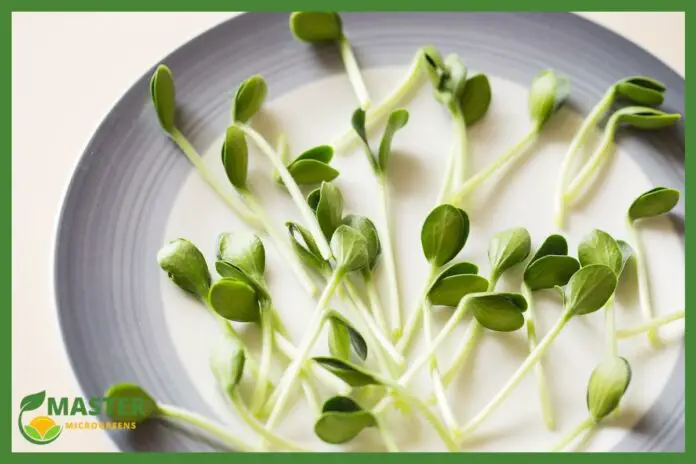Starting a microgreens business from scratch requires careful planning and execution. Researching the market to understand demand and competition is essential. Choosing the right seeds for your target market, gathering necessary supplies, creating optimal growing conditions, striving to maintain healthy and high-quality microgreens, and implementing effective marketing strategies are all crucial steps to ensure the success of your microgreens business.
What You'll Learn
Research the Market
You need to research the market before starting your microgreens business. It’s essential to identify potential customers and understand their needs. To do this, you should conduct a demand analysis to see what types of microgreens are in high demand.
Additionally, analyze customer profiles to determine who is most likely to buy them. You can use surveys or focus groups to get feedback from potential customers about what they want from a microgreens product. This will help you tailor your product offerings and know where best to advertise them.
Furthermore, researching competitors and understanding their pricing strategies will help you stay competitive in the marketplace. Studying industry trends can give you insight into new ideas for marketing your product and staying ahead of the competition.
With the right market research, you can position yourself for success when starting a microgreens business from scratch.
Choose Seeds
Pick a variety of seeds to get the most out of your microgreens business! You should select seeds that will give you a wide range of colors, flavors, and textures. Consider choosing different varieties from various categories such as herbs, vegetables, grains, and flowers.
Think about ways to maximize space saving by selecting seeds that have similar growth rates so you can have multiple crops growing at once. Make sure to investigate soil amendments for each type of seed you plan on using in order to optimize growth potential. For example, some plants may require more nitrogen-rich soil than others.
When researching what types of seeds would be best for your microgreens business, it’s important to look into how easy they are to grow and maintain. Consider if the plant requires any special care or treatments throughout its life cycle. Additionally, check if the seeds can handle being grown indoors or outdoors; some may need more sunlight than others in order to thrive.
You should also make sure that all the varieties you choose are safe for human consumption before planting them in your garden or greenhouse.
In addition to researching individual seed varieties, it’s important to look into where you will purchase them from as well as any regulations associated with selling food products from home or commercially produced farms/greenhouses. Before buying large quantities of seeds from a supplier, do research on their germination rate and quality standards; this is essential for successful crop yields! It is also wise to compare prices between vendors when making purchases so that you can find the best deal possible and save money in the long run.
Lastly, think about how much time and effort goes into properly preparing each type of seed for planting; some may require pre-soaking while others need specific temperatures during germination periods – all factors which must be taken into account when making your choice! As long as you take these steps into consideration when picking out different kinds of seeds for your microgreens business venture, you’ll be able to set yourself up for success now and down the road!
Gather Supplies
To get started with your microgreens business, you’ll need to gather some supplies. Firstly, you’ll need containers and soil that are suitable for growing your chosen seeds. Secondly, it’s important to consider lighting and temperature control – the right combination of both will ensure healthy growth of your microgreens.
Make sure you have all the necessary components in place before beginning the growing process!
Containers and soil
Considering what sort of containers and soil you’ll need to get started growing microgreens, have you thought about the ideal environment for your plants?
When it comes to choosing containers for your microgreens, you can select either plastic or fabric. The preferable choice is typically a container made of fabric, as this type of material allows air and water to pass through easily.
You’ll also want to pay close attention to soil quality when selecting the right soil for your microgreens. A good quality potting mix should contain a blend of organic matter like compost, perlite, coir, or peat moss. Additionally, make sure that the pH levels are appropriate and that the soil is free from pests or diseases before adding your seeds.
Plant selection is also important when creating an ideal environment for growing microgreens. Be sure to choose a variety that will thrive in the chosen environment and supplies you have available.
Lighting and temperature control
Light is essential for microgreens to flourish, so having the right temperature controls in place will help ensure your plants get the warmth they need to thrive.
Temperature and light intensity play a vital role in the growth of microgreens. To maintain an ideal environment for growing microgreens, you’ll need precise lighting and temperature control systems that can provide optimal levels of illumination and heat.
Depending on what type of lights you choose, you’ll want to make sure they provide enough light intensity to reach all areas of your growing containers. Additionally, you should also make sure that the temperature range is appropriate for your particular microgreen varieties; ideally between 65-75°F (18-24°C).
Investing in quality lighting and temperature control equipment can help create an ideal environment for your plants while ensuring your business runs smoothly.
Create Growing Conditions
Creating the ideal growing conditions for microgreens requires careful attention to detail; with each step in the process, you should be able to envision a thriving crop of nutritious greens.
The soil is the foundation for your microgreen business, so it’s important to use high quality, nutrient-rich soil. This will give your plants the best chance at growth and development.
Pest control is also an integral part of creating optimal growing conditions. Investing in natural pest control methods such as diatomaceous earth or neem oil can help keep pests away without harming your crops.
In addition, proper watering techniques are essential for keeping your microgreens healthy and strong. Watering too much or too little can lead to wilting or moldy leaves on plants that don’t have access to enough oxygen through their roots. Pay close attention to the moisture levels in your soil and water accordingly – make sure not to overwater!
Finally, monitoring temperature and humidity levels plays a big role in helping create an environment where microgreens can thrive. Temperatures between 65-80°F (18-26°C) are ideal for most types of microgreens while humidity should be kept around 70%. Keeping temperatures consistent is key; any sudden changes may stunt growth or cause plant disease.
By following these steps, you’ll set yourself up for success when starting a microgreen business from scratch. Once you have chosen your seeds, gathered supplies, created growing conditions, and monitored them regularly – all that’s left is marketing your product! With some research and dedication, you’ll be well on your way towards owning a successful business built around delicious, nutritious microgreens!
Maintain Microgreens
Maintaining microgreens is crucial for a successful business. Proper watering and air circulation are essential for healthy microgreens. Regular harvesting prevents overgrowth and overcrowding. To ensure your microgreens thrive, remember to water frequently and provide adequate ventilation throughout the growing process.
Proper watering and air circulation
Watering and air circulation are essential for success in growing microgreens, so don’t neglect it – your greens depend on it! To ensure the growth of healthy microgreens, you should:
- Monitor water quality to make sure that there’s no contamination.
- Ensure adequate air flow in the growing space. This can be done with fans or other ventilation systems.
- Regularly check for mold growth. If present, take steps to reduce humidity levels.
These three steps will help you keep your microgreens healthy and thriving while avoiding any potential issues that could arise from poor water or air circulation. It’s important to always pay attention to these key elements of a successful microgreens business and make adjustments as necessary.
Regular harvesting
Harvesting your microgreens regularly is crucial for keeping them fresh and tasty – don’t forget to give them the love they deserve! Proper harvesting techniques ensure you get the most out of your crop.
Depending on the type of microgreen being grown, you may need to harvest when the first two true leaves appear or wait until the whole plant has grown. Resource management is also important when harvesting. If one variety needs more water than another, be sure to adjust your watering schedule accordingly.
Harvesting in smaller batches will help maintain quality and prevent waste. With practice and experience, you’ll find that regular harvesting is an important part of owning a successful microgreens business.
Market Your Product
Once you’ve successfully grown your microgreens, it’s time to start thinking about how you’re going to market them! The first step is to promote your product locally.
You can do this by approaching local restaurants and grocery stores, or by setting up a booth at farmers’ markets. Make sure that you’re using effective pricing strategies when selling your microgreens; research prices for similar products in the area so that you can price competitively. Additionally, be sure to emphasize the superior freshness of your product as compared to other options.
Another way you can market your product is through online platforms like social media, blogs, and even crowdfunding campaigns. Utilize these tools to create an online presence for yourself and your business.
Share photos of your microgreens on Instagram and Twitter, write blog posts about the benefits of eating microgreens, or launch a Kickstarter campaign for new growing supplies that will help expand production. This will also give potential customers an opportunity to get to know more about what makes your business unique and why they should buy from you instead of other vendors in the area.
You may also want to consider creating marketing materials such as flyers or brochures with information about what types of microgreens are available and their nutritional value.
Include pictures of some of the different varieties along with any relevant contact information so people know where they can purchase them from you directly or find out more information about them online. Finally, word-of-mouth advertising is always one of the most powerful forms of marketing – make sure all happy customers are aware that they can spread the word about their experience with your microgreen products!





